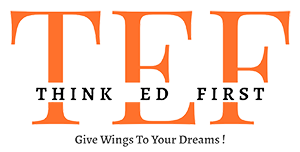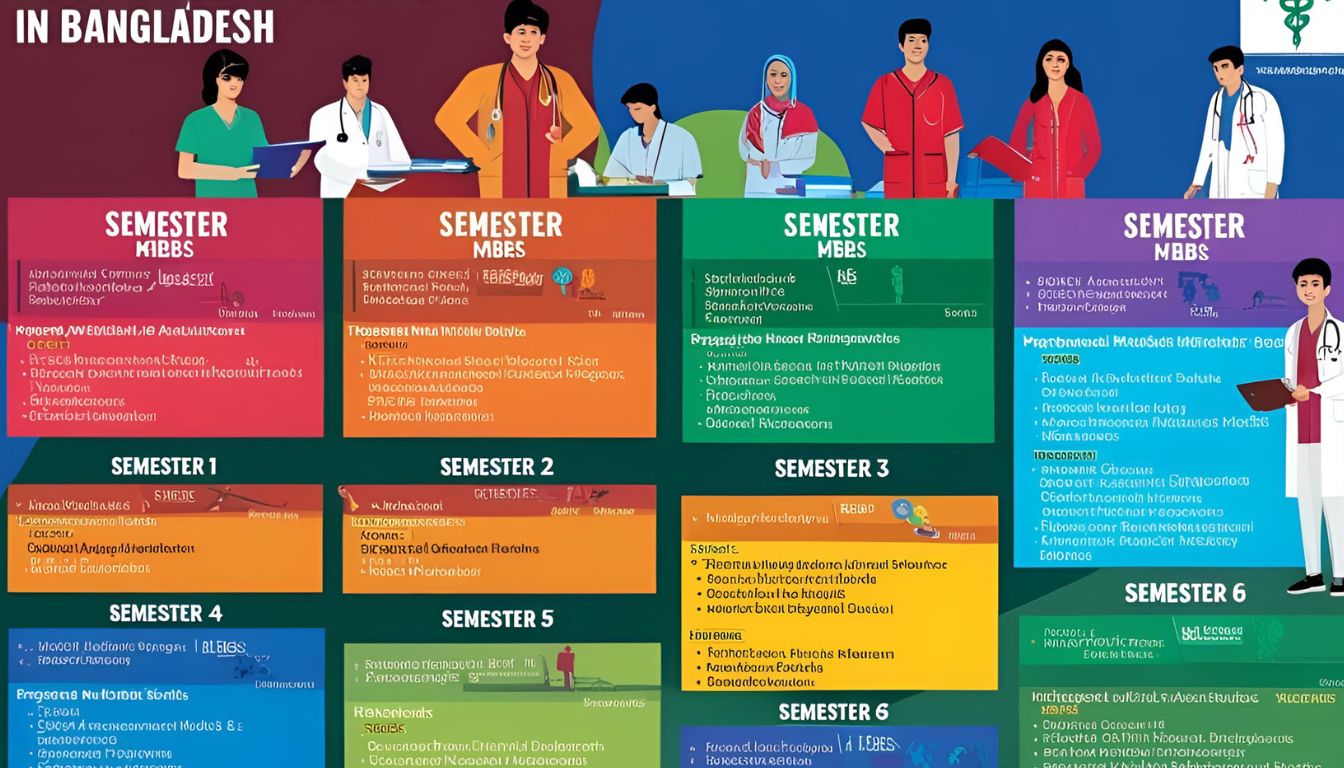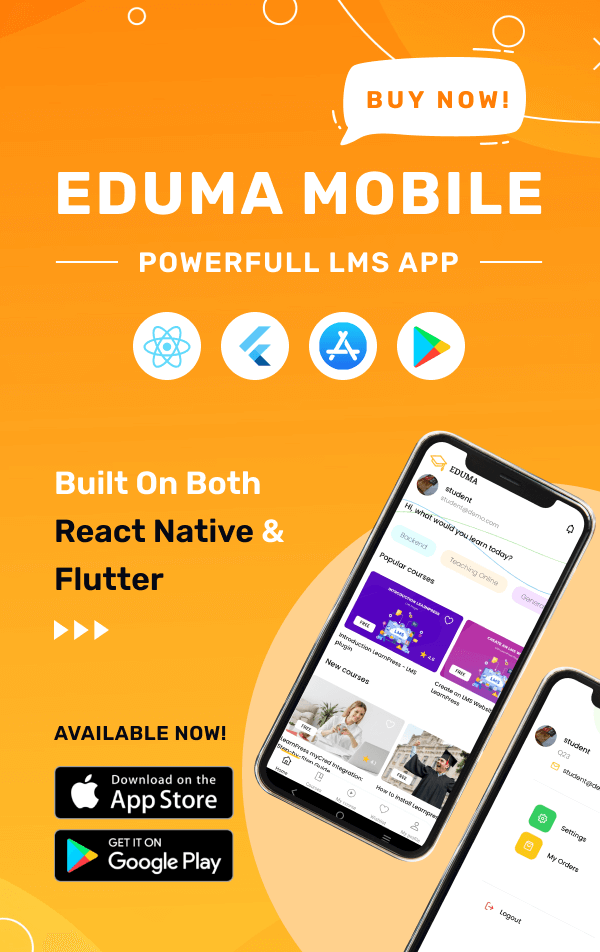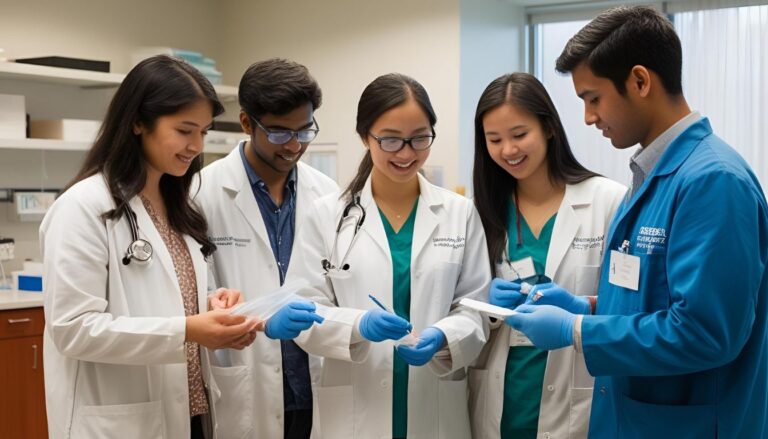Have you ever wondered why so many Indian students choose to pursue their medical education in Bangladesh? The answer lies in a unique blend of affordability, cultural familiarity, and global recognition. For aspiring doctors, this neighboring country has become a top destination, offering a pathway to a respected medical degree.
Bangladesh’s medical colleges are accredited by global bodies like WHO and MCI, ensuring that degrees are recognized worldwide. The 5+1 year structure, which includes a year-long internship, aligns with international standards. This makes it easier for graduates to practice medicine globally.
Additionally, the cost of studying here is significantly lower compared to many other countries. From tuition fees to living expenses, the financial burden is much lighter. For Indian students, the cultural similarities and proximity to home make the transition smoother.
In this guide, we’ll explore the detailed costs and benefits of pursuing a medical degree in Bangladesh. Whether you’re a student or a parent, this information will help you make an informed decision. Let’s dive in!
Why Pursue MBBS in Bangladesh?
What makes Bangladesh a top choice for Indian students seeking medical education? The answer lies in its affordability, cultural familiarity, and global recognition. Over 7,000 Indian students enroll annually, drawn by the lower costs and high-quality programs.
One of the biggest advantages is the cost. Tuition fees in Bangladesh are 40-60% cheaper compared to private medical colleges in India. For example, the total cost of an MBBS course in Bangladesh ranges from INR 25-40 lakhs, while in India, it can go up to INR 50 lakhs to 1 crore or more.
Another benefit is the NEET exemption for admissions. Students can apply without needing to clear the NEET exam, making the process simpler and more accessible. This is a major relief for many aspirants.
Cultural similarities also play a significant role. The Bengali language, cuisine, and geographic proximity to Eastern India make the transition smoother for Indian students. Additionally, English is the medium of instruction, eliminating language barriers and ensuring a comfortable learning environment.
Degrees from Bangladeshi medical colleges are recognized by global bodies like WHO and MCI. This ensures that graduates are eligible for FMGE/NExT exams, allowing them to practice medicine in India or abroad. With these advantages, it’s no wonder Bangladesh is a popular destination for medical education.
- Affordable tuition fees compared to Indian private colleges.
- NEET exemption simplifies the admission process.
- Cultural similarities make adaptation easier.
- English-medium instruction ensures seamless learning.
- Degrees recognized by WHO and MCI for global practice.
Semester-wise Expense Breakdown for MBBS in Bangladesh
Planning your medical education involves knowing the costs at every stage. For Indian students, studying abroad can be affordable if you understand the expenses involved. Let’s explore the financial aspects of each phase of the program.
Pre-Clinical Phase (Years 1-2)
The first two years focus on foundational medical knowledge. Costs include tuition, accommodation, and study materials. This phase sets the groundwork for the rest of the program.
Para-Clinical Phase (Year 3)
In the third year, students transition to practical learning. Expenses may include lab fees and additional resources. This phase bridges theoretical knowledge with hands-on experience.
Clinical Phase (Years 4-5)
During these years, students engage in hospital rotations. Costs may rise due to travel and clinical supplies. This phase prepares students for real-world medical practice.
Internship (Year 6)
The final year involves a mandatory internship in affiliated hospitals. Students earn a stipend of INR 5,000-10,000 per month. This phase is crucial for gaining practical experience and completing certification requirements.
| Phase | Key Expenses |
|---|---|
| Pre-Clinical | Tuition, accommodation, study materials |
| Para-Clinical | Lab fees, additional resources |
| Clinical | Travel, clinical supplies |
| Internship | Living costs, visa extensions |
- Certification is required post-internship to practice medicine.
- Visa extensions may be needed to complete the program.
- Living costs during the internship phase should be budgeted.
Tuition Fees Across Top Medical Colleges
Understanding tuition fees is crucial for planning your medical education abroad. Costs can vary significantly depending on the institution you choose. In Bangladesh, both public and private medical colleges offer programs that cater to international students.
Public Universities
Public universities are known for their affordability. However, admission can be highly competitive. These institutions often have lower tuition fees compared to private medical colleges, making them an attractive option for many students.
Private Institutions
Private medical colleges provide more flexibility in terms of admission and payment options. While tuition fees are higher, these institutions often offer modern facilities and a more personalized learning experience. For example, Dhaka National Medical College charges a total fee of INR 33.6 lakhs, while Sylhet Women’s Medical College costs INR 32 lakhs.
Payment flexibility is another advantage of private institutions. Many colleges allow students to pay in installments, reducing the financial burden. This is particularly helpful for families managing their budgets carefully.
| College | Total Tuition Fee (INR) |
|---|---|
| Dhaka National Medical College | 33,60,000 |
| Sylhet Women’s Medical College | 32,00,000 |
| Barind Medical College | 25,95,000 |
| Green Life Medical College | 31,50,000 |
| Enam Medical College | 27,30,000 |
When choosing a college, it’s important to consider both the cost and the quality of education. Whether you opt for a public or private institution, understanding the financial commitment will help you make an informed decision.
Living Costs for International Students
Managing daily expenses is a key concern for students studying abroad. For Indian students, understanding the cost of living in Bangladesh helps in planning a budget-friendly stay. On average, monthly expenses range between INR 8,000 to INR 12,000, covering accommodation, food, transport, and leisure.
Accommodation is a major part of the budget. On-campus hostels are affordable, with fees ranging from INR 3,000 to INR 8,000 per month. Off-campus housing offers more freedom but may cost slightly more. Both options provide a comfortable living environment for students.
Food expenses are manageable, with local meals costing around INR 150-200 per day. Public transport is also budget-friendly, with monthly passes available for INR 750-1,500. Students can explore leisure activities without overspending, thanks to affordable entertainment options.
- Accommodation: On-campus hostels are cost-effective, while off-campus offers flexibility.
- Food: Local meals are affordable, with daily expenses around INR 150-200.
- Transport: Public transport is inexpensive, with monthly passes under INR 1,500.
- Leisure: Entertainment options are budget-friendly, allowing students to enjoy their stay.
By planning wisely, Indian students can manage their living costs effectively while studying in Bangladesh. This ensures a stress-free and enjoyable educational experience.
Scholarships and Financial Aid
Financial support can make a significant difference in pursuing medical studies abroad. Many institutions in Bangladesh offer scholarships and aid to help students manage costs. These opportunities can cover a portion of tuition fees, making education more accessible.
Merit-based scholarships are a popular option. They typically cover 10-50% of tuition fees, depending on academic performance. For example, students with a CGPA of 3.70 or higher may qualify for up to 100% fee waivers. These scholarships reward hard work and dedication.
Need-based aid is also available. Institutions like BUP provide financial assistance to students from economically disadvantaged backgrounds. This ensures that talented individuals can pursue their dreams without financial barriers.
Government schemes further support South Asian students. These programs aim to strengthen educational ties and provide opportunities for international collaboration. Students should explore these options to maximize their financial aid.
| Scholarship Type | Coverage | Eligibility |
|---|---|---|
| Merit-Based | 10-50% of fees | Minimum CGPA of 3.00 |
| Need-Based | Full or partial fees | Economic disadvantage |
| Government Schemes | Varies | South Asian citizenship |
To apply, students must meet specific criteria, such as maintaining a certain CGPA or completing credit hour requirements. Early preparation and thorough research can help secure these financial aids. With the right support, studying at medical universities in Bangladesh becomes a viable and affordable option.
Eligibility Criteria for Indian Students
Understanding the eligibility criteria is the first step toward pursuing a medical degree abroad. For Indian students, specific academic and age requirements must be met to qualify for admission. Let’s explore these in detail.
Students must have a minimum of 60% in Physics, Chemistry, and Biology (PCB) in their 10+2 exams. Additionally, being NEET qualified is mandatory for most programs. This ensures that applicants have a strong foundation in the sciences.
The age limit for applicants is typically between 17 and 25 years. This range ensures that students are at the right stage in their academic journey to begin medical studies. It’s important to verify these details with the chosen institution.
Preparing the necessary documents is crucial for a smooth admission process. Here’s a checklist to help you get started:
- Passport with at least six months validity.
- Academic transcripts from 10th and 12th grades.
- Medical fitness certificate from a recognized practitioner.
- Equivalence certificate to validate your academic qualifications.
The equivalence certificate is particularly important. It confirms that your Indian qualifications meet the standards of the host country. Ensure all documents are attested by the Bangladesh Mission Abroad and your country’s Education Ministry.
By meeting these criteria and preparing your documents in advance, you can streamline the admission process. This ensures a hassle-free start to your medical education journey.
Admission Process Simplified
Navigating the admission process for medical studies can seem overwhelming, but we’re here to simplify it. For Indian students, securing a seat involves timely applications and proper documentation. Let’s break it down step by step.
Key Steps to Follow
- University Selection: Research accredited colleges and submit online applications by November–December.
- Document Upload: Attach scanned copies of your 10th/12th mark sheets, passport, and medical certificates.
- Offer Letter: Await confirmation from the college, usually within 2–4 weeks.
- Fee Payment: Pay the first-year tuition to secure your seat.
- Visa Application: Apply immediately, as processing takes 4–6 weeks.
Visa Requirements
Ensure you have these documents ready for a smooth visa process:
| Document | Details |
|---|---|
| Passport | Valid for 6+ months, with photocopies. |
| Academic Certificates | Attested by the Bangladesh Mission. |
| Offer Letter | Original copy from the college. |
Free counseling services, like those from Rus Education, can guide you through each stage. They help with university shortlisting, document checks, and interview prep.
Stick to deadlines and double-check requirements to avoid delays. With the right approach, your journey to a medical degree begins smoothly.
Duration and Structure of MBBS Programs
Understanding the structure of medical programs is key to planning your education. The program typically spans 5 years of academic study, followed by a 1-year internship. This phased approach ensures students gain both theoretical knowledge and practical skills.
The curriculum is divided into three main phases: pre-clinical, para-clinical, and clinical. Each phase builds on the previous one, preparing students for real-world medical practice. The program’s structure aligns with global standards, making it easier for graduates to pursue opportunities worldwide.
To prepare for exams like FMGE and NExT, the curriculum emphasizes practical training. Students spend significant time in hospitals and clinics, gaining hands-on experience. This ensures they are well-equipped to meet professional challenges.
The grading system and credit structure are designed to meet international standards. This helps students track their progress and stay motivated throughout the program. For those considering other options, MBBS programs in China offer a similar structured approach.
- The program’s duration includes 5 years of academics and 1 year of internship.
- Phases focus on building a strong foundation for clinical practice.
- Practical training prepares students for global medical exams.
- Grading and credit systems align with international standards.
Medium of Instruction: English Advantage
Studying in an English-medium environment offers significant advantages for international students. In Bangladesh, all lectures are conducted in English, ensuring a seamless learning experience. This eliminates language barriers and allows students to focus entirely on their studies.
English proficiency also plays a crucial role in preparing for global medical exams like USMLE and PLAB. Students have access to study materials and resources in English, making exam preparation more effective. This advantage is particularly beneficial for those aiming to practice medicine internationally.
For non-native speakers, language support is often available. Many institutions provide additional resources to help students improve their English skills. This ensures that everyone can fully participate in the program and excel in their studies.
Here’s a quick overview of the benefits of English-medium instruction:
| Advantage | Details |
|---|---|
| Global Access | English-medium programs are recognized worldwide, making it easier to pursue opportunities abroad. |
| Exam Preparation | Access to English resources aids in preparing for USMLE, PLAB, and other international exams. |
| Language Support | Additional resources are available for non-native speakers to improve their English proficiency. |
If you’re considering studying MBBS abroad at low cost, English-medium programs in Bangladesh are an excellent choice. They provide a strong foundation for a successful medical career while ensuring a comfortable learning environment.
Top Medical Colleges in Bangladesh
Choosing the right medical college is a critical step for aspiring doctors. In Bangladesh, several institutions stand out for their quality education, modern facilities, and affordability. Let’s explore some of the top options available for international students.
Dhaka National Medical College
Located in Jonson Road, Dhaka, this college is known for its excellent infrastructure and experienced faculty. The total tuition fee is INR 42.4 lakhs, which includes hostel facilities. Students enjoy 24-hour access to hot and cold water, gas, and electricity, ensuring a comfortable stay.
Dhaka National Medical College also provides opportunities for rural healthcare exposure through its internship programs. This hands-on experience prepares students for real-world medical challenges.
Sylhet Women’s Medical College
Situated in Naya Sadak, Sylhet, this institution is a popular choice for female students. The total tuition fee is INR 33.6 lakhs, including hostel costs. The college offers a supportive learning environment with modern amenities.
Students here gain valuable experience through internships at top hospitals. This exposure helps them develop the skills needed for a successful medical career.
Barind Medical College
Located in Boalia, Rajshahi, Barind Medical College is known for its focus on rural healthcare. The total tuition fee is INR 25.3 lakhs, with hostel facilities included. This makes it an affordable option for students seeking quality education.
The college provides unique opportunities for rural healthcare exposure, allowing students to work in underserved areas. This experience is invaluable for those looking to make a difference in their communities.
- Dhaka National Medical College offers modern facilities and rural healthcare exposure.
- Sylhet Women’s Medical College provides a supportive environment for female students.
- Barind Medical College focuses on affordable education and rural healthcare experience.
Recognition of Bangladeshi Medical Degrees
When choosing a medical program, recognition of your degree is a critical factor. Degrees from accredited institutions in Bangladesh are globally recognized by organizations like WHO, MCI, and ECFMG. This ensures graduates can pursue opportunities worldwide, including the ability to practice medicine in India.
The FMGE pass rate for graduates from Bangladesh is around 25-30%. While this highlights the need for thorough preparation, it also underscores the quality of education that aligns with international standards. The curriculum is designed to meet the requirements of licensing exams like FMGE and NExT, making it easier for students to transition into professional practice.
Bangladeshi medical degrees are accepted in several countries, including:
- India (recognized by the National Medical Commission)
- Sri Lanka (recognized by the Sri Lanka Medical Council)
- United States (recognized by ECFMG)
- United Kingdom (recognized by GMC)
In 2023, the NMC introduced updates to its screening test process. These changes aim to streamline the evaluation of international medical graduates, ensuring they meet the standards required to practice medicine in India. Staying informed about these updates is essential for aspiring doctors.
With global recognition and a curriculum aligned with international standards, Bangladeshi medical degrees offer a strong foundation for a successful career. Whether you aim to practice medicine in India or abroad, understanding the recognition of your degree is key to achieving your goals.
Post-MBBS Opportunities for Indian Graduates
Completing your medical degree opens doors to global opportunities. Indian graduates can pursue diverse career paths, from practicing medicine to furthering their education. Let’s explore the options available after completing your program.
Graduates are eligible to take licensing exams like USMLE, PLAB, and FMGE/NExT. These exams allow you to practice medicine in countries like the USA, UK, and India. The curriculum aligns with international standards, ensuring you’re well-prepared for these tests.
For those aiming to practice in India, clearing the FMGE or NExT exam is mandatory. These exams validate your qualifications and ensure you meet the standards required by the National Medical Commission. Many graduates from recognized programs achieve high pass rates, making this a viable path.
Post-graduate studies are another popular option. Graduates can pursue specialized courses in the UK, USA, or India. Institutions like Rus Education offer counseling services to guide you through the application process. They help with university selection, exam preparation, and visa procedures.
| Exam | Eligibility | Purpose |
|---|---|---|
| USMLE | Graduates from recognized medical universities | Practice in the USA |
| PLAB | Graduates from WHO-recognized programs | Practice in the UK |
| FMGE/NExT | Indian graduates from foreign medical universities | Practice in India |
Whether you aim to practice medicine or pursue advanced studies, the opportunities are vast. With the right guidance and preparation, you can achieve your career goals and make a meaningful impact in the field of medicine.
Comparison: MBBS in Bangladesh vs. India
When deciding where to pursue a medical degree, comparing options can provide clarity. Both Bangladesh and India offer quality education, but there are key differences to consider. Let’s explore how these two destinations stack up.
One of the biggest differences is the cost. Medical education in Bangladesh is 50% more affordable than private institutions in India. This makes it a budget-friendly option for many students. Additionally, Bangladesh reserves 25% of its seats for Indian students, increasing accessibility.
Admission competitiveness is another factor. In India, securing a seat in a government college can be highly challenging due to limited availability. In contrast, Bangladesh offers a simpler admission process without entrance exams like NEET. This reduces stress for aspiring doctors.
Return on investment (ROI) is also worth considering. With lower tuition and living costs, students in Bangladesh often achieve a higher ROI. The degrees are globally recognized, allowing graduates to practice in India or abroad after clearing licensing exams.
Here’s a quick comparison of the two options:
- Cost: Bangladesh is 50% cheaper than private Indian colleges.
- Admission: No entrance exams required in Bangladesh, unlike India.
- Seat Availability: Bangladesh reserves 25% of seats for Indian students.
- ROI: Lower costs in Bangladesh lead to higher returns.
Cultural and geographic proximity to India makes Bangladesh an attractive choice. The similarities in language, food, and lifestyle help Indian students adjust more easily. This adds to the overall appeal of studying there.
In summary, both destinations have their strengths. However, for those seeking affordability, accessibility, and a smoother transition, Bangladesh stands out as a compelling option.
Safety and Student Life in Bangladesh
Safety and student life are key factors for international students choosing a South Asian country for their studies. Bangladesh offers a secure environment with low crime rates in cities like Dhaka and Sylhet. On-campus security measures, including CCTV surveillance, ensure a safe living and learning experience.
Cultural festivals are a highlight of student life here. Indian students can enjoy familiar traditions and celebrations, making the transition smoother. The availability of Indian food adds to the comfort, with many local restaurants serving authentic dishes.
Travel within the country is convenient and affordable. Students can explore nearby cities and tourist spots during breaks. This enhances their overall experience and provides a well-rounded education.
Support systems are in place to assist students. Dedicated student support cells help with academic and personal challenges. Health insurance is also available, ensuring access to medical care when needed.
- Low crime rates and on-campus security create a safe environment.
- Cultural festivals and Indian food make students feel at home.
- Convenient travel options allow exploration of the country.
- Student support cells and health insurance provide additional assistance.
Essential Documents for Admission
Gathering the right documents is the first step toward securing your medical education abroad. Proper preparation ensures a smooth admission process and avoids unnecessary delays. Here’s a detailed guide to help you organize your paperwork efficiently.
The following documents are essential for the admission process:
- Passport: Ensure your passport is valid for at least one year from the application date.
- NEET Scorecard: If you’re NEET qualified, include your scorecard as proof of eligibility.
- 10+2 Marksheets: Submit your academic transcripts from high school, attested by the appropriate authorities.
- Medical Fitness Certificate: Obtain a certificate from a recognized practitioner, including an HIV report.
Notarization and apostille are often required for certain documents. Ensure your academic papers are verified and attested by the Bangladesh Mission Abroad or your country’s Education Ministry. This step is crucial for validating your qualifications.
Document submission timelines vary by institution. Most colleges require applications by November–December, so start preparing early. Double-check deadlines to avoid missing critical dates.
By organizing your documents in advance, you can streamline the admission process and focus on your medical education journey. Proper preparation ensures a hassle-free experience and sets you up for success.
Conclusion
Pursuing a medical degree abroad can be a life-changing decision, and choosing the right destination is crucial. Studying in Bangladesh offers a cost-effective pathway to a globally recognized qualification. The affordability, combined with cultural similarities, makes it an ideal choice for Indian students.
We encourage aspiring doctors to start their applications early through authorized partners like Rus Education. This ensures a smooth admission process and timely preparation for the journey ahead.
In summary, Bangladesh provides a unique blend of affordability, global recognition, and cultural fit. It’s a destination that opens doors to a successful medical career while keeping costs manageable.





